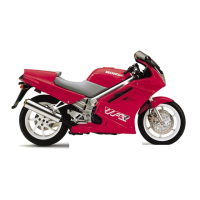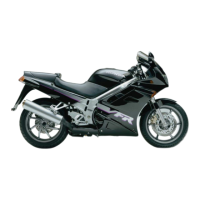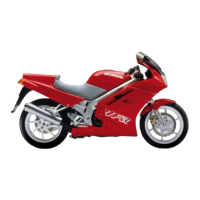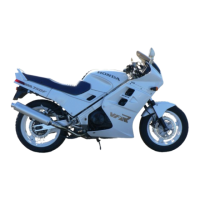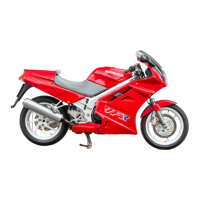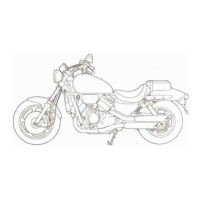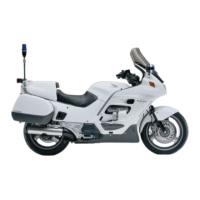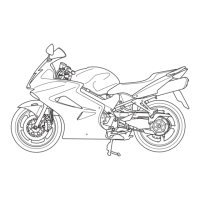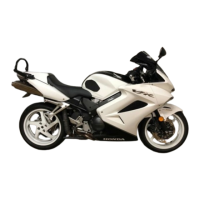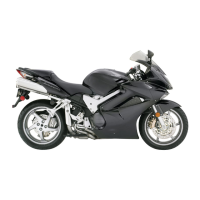Do you have a question about the Honda VFR750F 1995 and is the answer not in the manual?
Specifies carrying capacity and weight limits for safe operation.
Motorcycle is designed for road use only, not off-road.
Emphasizes reading safety messages and manual for safe riding.
Explains the meaning of DANGER, WARNING, CAUTION safety message indicators.
Explains the meaning of NOTICE for preventing damage to property or environment.
Covers general safety aspects like protective gear and riding tips.
Explains the function of all dashboard instruments and warning lights.
Details essential parts like suspension and their adjustments.
Covers brake fluid checks, lever adjustments, and system maintenance.
Details clutch fluid checks and lever adjustments.
Explains fuel tank operation, capacity, and refueling safety.
Guides on checking engine oil level and recommendations.
Covers tire pressure, inspection, wear, repair, and replacement.
Outlines essential checks before riding the motorcycle for safety.
Provides detailed procedures for starting the engine in various conditions.
Outlines engine break-in procedures and speed limits for initial miles.
Explains braking techniques and safety reminders for effective stopping.
Stresses the importance of helmets for reducing head injury severity.
Advises constant awareness and anticipation of other drivers' actions.
Emphasizes pre-ride inspection and regular maintenance for safety.
Details the importance and features of helmets and eye protection.
Discusses safe weight limits, proper loading techniques, and cargo securing.
Warns against modifications affecting handling, safety, or legality.
Lists recommended cold tire pressures for front and rear tires.
Explains adjustments for front and rear suspension spring preload and damping.
Guides on checking front brake fluid level and recommended fluid type.
Guides on checking rear brake fluid level and recommended fluid type.
Details checking the clutch fluid level and identifying potential leaks.
Guides on checking engine oil level and recommendations.
Details how to change engine oil and filter, and proper disposal.
Step-by-step guide to draining oil and removing the oil filter.
Guides on installing the new oil filter, drain plug, and filling oil.
Explains the importance of proper tire inflation for handling and safety.
Covers inspecting tire treads and sidewalls for wear, damage, and foreign objects.
Recommends replacing damaged tires and discusses limitations of repaired tires.
Emphasizes checking gauges and lights as part of the pre-ride inspection.
Lists checks required before starting the engine, like neutral and indicators.
Outlines engine break-in procedures and speed limits for initial miles.
Details recommended speeds for upshifting and downshifting gears.
Explains braking techniques and safety reminders for effective stopping.
Explains why regular maintenance is essential for safe and economical riding.
Highlights safety precautions for performing maintenance tasks.
Lists safety measures like turning off engine, cooling parts, and fire prevention.
Details inspecting electrodes, cleaning, and checking spark plug gap.
Guides on threading and tightening spark plugs to prevent cross-threading and engine damage.
Guides on checking chain slack and for kinks or binding.
Provides steps for adjusting drive chain slack and torque specifications.
Explains how to check for blown fuses and replace them safely.
Specifies carrying capacity and weight limits for safe operation.
Motorcycle is designed for road use only, not off-road.
Emphasizes reading safety messages and manual for safe riding.
Explains the meaning of DANGER, WARNING, CAUTION safety message indicators.
Explains the meaning of NOTICE for preventing damage to property or environment.
Covers general safety aspects like protective gear and riding tips.
Explains the function of all dashboard instruments and warning lights.
Details essential parts like suspension and their adjustments.
Covers brake fluid checks, lever adjustments, and system maintenance.
Details clutch fluid checks and lever adjustments.
Explains fuel tank operation, capacity, and refueling safety.
Guides on checking engine oil level and recommendations.
Covers tire pressure, inspection, wear, repair, and replacement.
Outlines essential checks before riding the motorcycle for safety.
Provides detailed procedures for starting the engine in various conditions.
Outlines engine break-in procedures and speed limits for initial miles.
Explains braking techniques and safety reminders for effective stopping.
Stresses the importance of helmets for reducing head injury severity.
Advises constant awareness and anticipation of other drivers' actions.
Emphasizes pre-ride inspection and regular maintenance for safety.
Details the importance and features of helmets and eye protection.
Discusses safe weight limits, proper loading techniques, and cargo securing.
Warns against modifications affecting handling, safety, or legality.
Lists recommended cold tire pressures for front and rear tires.
Explains adjustments for front and rear suspension spring preload and damping.
Guides on checking front brake fluid level and recommended fluid type.
Guides on checking rear brake fluid level and recommended fluid type.
Details checking the clutch fluid level and identifying potential leaks.
Guides on checking engine oil level and recommendations.
Details how to change engine oil and filter, and proper disposal.
Step-by-step guide to draining oil and removing the oil filter.
Guides on installing the new oil filter, drain plug, and filling oil.
Explains the importance of proper tire inflation for handling and safety.
Covers inspecting tire treads and sidewalls for wear, damage, and foreign objects.
Recommends replacing damaged tires and discusses limitations of repaired tires.
Emphasizes checking gauges and lights as part of the pre-ride inspection.
Lists checks required before starting the engine, like neutral and indicators.
Outlines engine break-in procedures and speed limits for initial miles.
Details recommended speeds for upshifting and downshifting gears.
Explains braking techniques and safety reminders for effective stopping.
Explains why regular maintenance is essential for safe and economical riding.
Highlights safety precautions for performing maintenance tasks.
Lists safety measures like turning off engine, cooling parts, and fire prevention.
Details inspecting electrodes, cleaning, and checking spark plug gap.
Guides on threading and tightening spark plugs to prevent cross-threading and engine damage.
Guides on checking chain slack and for kinks or binding.
Provides steps for adjusting drive chain slack and torque specifications.
Explains how to check for blown fuses and replace them safely.
| Bore x Stroke | 70.0mm x 48.6mm |
|---|---|
| Compression Ratio | 11.0:1 |
| Transmission | 6-speed |
| Front Brakes | Dual 296 mm discs with 2-piston calipers |
| Rear Brakes | Single 256 mm disc with 2-piston caliper |
| Front Tire | 120/70-ZR17 |
| Rear Tire | 170/60-ZR17 |
| Engine Type | 4-stroke, DOHC, V4 |
| Ignition | Digital transistorized with electronic advance |
| Final Drive | O-ring chain |
| Front Suspension | 41 mm telescopic fork, adjustable preload |
| Rear Suspension | Pro-Link with adjustable preload and rebound damping |
| Fuel Capacity | 19 L (5.0 US gal) |
